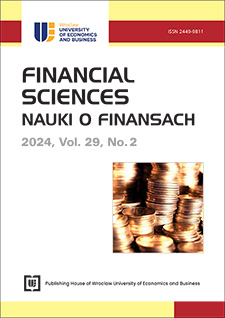Cointegration and Regression Analyses as Alternative Methods to Verify the Protective Properties of Inflation Hedge Investments
DOI:
https://doi.org/10.15611/fins.2024.2.02Keywords:
investments, inflation hedging, portfolio, real estate, PolandAbstract
Aim: In the face of rising inflation, a variety of financial tools are increasingly important to protect capital from loss of value. This leads to questions about which investment to choose to protect capital from loss of value. The purpose of the work was to determine whether selected investment directions on the Polish capital market can protect capital against inflation-related loss of value.
Methodology: The study used a cointegration analysis using the Engle-Granger test and a regression analysis using the OLS method. The research covered the period from Q4 2008 to Q4 2022, using the bond TBSP index, Bitcoin and gold, the WIG index, the WIG Real Estate stock index and the NBP hedonic index of property prices in the seven largest cities in Poland. These investments were related to the HICP harmonised inflation index published by the European Statistical Office (EUROSTAT).
Findings: The analysis revealed different results depending on the survey methodology adopted. The co-integration analysis pointed to Bitcoin as an inflation hedging investment, whereas the regression analysis pointed to gold and residential property as inflation combined.
Implications: The study enables a better understanding of the complex dynamics involved in preserving purchasing power during periods of high inflation.
Originality/value: The study is an important contribution to filling the gaps in the Polish market in terms of analysis of capital protection options against inflation. Although the study focused only on the Polish market, this topic has not been addressed through a period of low inflation also in mature economies.
Downloads
References
Arnold, S., & Auer, B. R. (2015). What Do Scientists Know about Inflation Hedging? The North American Journal of Economics and Finance, 34, 187-214. https://doi.org/10.1016/j.najef.2015.08.005
Aye, G. C., Chang, T., & Gupta, R. (2016). Is Gold an Inflation-hedge? Evidence from an Interrupted Markov-switching Cointegration Model. Resources Policy, 48, 77-84.
Bird, P. J. W. N. (1984). Commodities as a Hedge against Inflation. Applied Economics, 16(6), 855. https://doi.org/10.1080/00036848400000055
Bodie, Z. (1976). Common Stocks as a Hedge against Inflation. Journal of Finance (Wiley-Blackwell), 31(2), 459-470. https://doi.org/10.1111/j.1540-6261.1976.tb01899.x
Bond, M. T., & Seiler, M. J. (1998). Real state Returns and Inflation: An Added Variable Approach. The Journal of Real Estate Research, 15(3), 327-338. http://www.jstor.org/stable/24886883
Choi, S., & Shin, J. (2022). Bitcoin: An Inflation Hedge but not a Safe Haven. Finance Research Letters, 46, 102379. https://doi.org/10.1016/j.frl.2021.102379
Engle, R. F., & Granger, C. W. (1987). Co-integration and Error Correction: Representation, Estimation, and Testing. Econometrica: Journal of the Econometric Society, 55(2), 251-276.
Fama, E. F., & Schwert, G. W. (1977). Asset Returns and Inflation. Journal of Financial Economics, 5(2), 115-146.
Fang, W. S., Wang, K. M., & Nguyen, T. B. T. (2008). Is Real Estate Really an Inflation Hedge? Evidence from Taiwan. Asian Economic Journal, 22(2), 209-224.
Fisher, I. (1930). The Theory of Interest. Macmillan, .
Fiszeder, P., & Rowiński, S. (2012). Modelowanie zależności pomiędzy wybranymi procesami makroekonomicznymi a warszawskim indeksem giełdowym. Ekonomia i Prawo, 10(3), 153-167.
Fogler, H. R. (1984). 20% in Real Estate: Can Theory Justify It? Journal of Portfolio Management, 10(2), 6-13. https://doi.org/10.3905/jpm.1984.6
Foryś, I. (2016). Indeksy cen nieruchomości dla małych obszarów. Studia i Prace WNEiZ US, 45(2), 37-48.
Ghazali, M. F., Lean, H. H., & Bahari, Z. (2015). Is Gold a Good Hedge Against Inflation? Empirical Evidence in Malaysia. Kajian Malaysia, 33(1), 69-84.
Hoesli, M., & MacGregor, B. D., (2000). Property Investment: Principles and Practice of Portfolio Management. Pearson Education.
Kasprzak-Czelej, A. (2015). Inwestycje w złoto jako zabezpieczenie przed inflacją w Polsce. Annales Universitatis Mariae Curie-Skłodowska, Sectio H Oeconomia, 49(4), 205-214. https://doi.org/10.17951/h.2015.49.4.205
Kucharska-Stasiak, E. (2009). Nieruchomość w gospodarce rynkowej. Wydawnictwo Naukowe PWN.
Le Long, H., De Ceuster, M. J., Annaert, J., & Amonhaemanon, D. (2013). Gold as a Hedge Against Inflation: The Vietnamese case. Procedia Economics and Finance, 5, 502-511. https://doi.org/10.1016/S2212-5671(13)00059-2
Lee, H. K. N. (2013). A Cointegration Analysis of Inflation and Real Estate Returns. The Journal of Real Estate Portfolio Management, 19(3), 207-224. http://www.jstor.org/stable/24885540
Lee, S. P., & Isa, M. (2019). Inflation Hedging Properties of Different Asset Classes in Malaysia. Asian Journal of Business and Accounting, 12(1), 229-256. https://doi.org/10.22452/ajba.vol12no1.8 Information Science Society, September 30. https://doi.org/10.7465/jkdi.2016.27.5.1399 Lee, C., Park, S., & Jeong, J. (2016). Comprehensive Comparison of Normality Tests: Empirical Study Using Many Different Types of Data. Journal of the Korean Data and Information Science Society. 27(5), 1399-1412, Korean Data and
Lintner, J. (1975). Inflation and Security Returns. The Journal of Finance, 30(2), 259-280.
Markowitz, H. M. (1952). Portfolio Selection. Journal of Finance, 7, 77-91.
Matkovskyy, R., & Jalan, A. (2021). Can Bitcoin Be an Inflation Hedge? Evidence from a Quantile-on-Quantile Model. Revue Économique, 72(5), 785-798. https://www.jstor.org/stable/48618930
Melnychenko, O., Osadcha, T., Kovalyov, A., & Matskul, V. (2022). Dependence of Housing Real Estate Prices on Inflation as One of the Most Important Factors: Poland’s Case. Real Estate Management and Valuation, 30(4), 25-41. https://doi.org/10.2478/remav-2022-0027
Obereiner, D., & Kurzrock, B. M. (2012). Inflation‐hedging Properties of Indirect Real Estate Investments in Germany. Journal of Property Investment & Finance, 30(3), 218-240.
Phochanachan, P., Pirabun, N., Leurcharusmee, S., & Yamaka, W. (2022). Do Bitcoin and Traditional Financial Assets Act as an Inflation Hedge during Stable and Turbulent Markets? Evidence from High Cryptocurrency Adoption Countries. Axioms (2075-1680), 11(7), 339–N.PAG. https://doi.org/10.3390/axioms11070339
Salisu, A. A., Raheem, I. D., & Ndako, U. B. (2020). The Inflation Hedging Properties of Gold, Stocks and Real Estate: A Comparative Analysis. Resources Policy, 66, 101605.
Sharpe, W. F. (1967). Portfolio Analysis. Journal of Financial and Quantitative Analysis, 2(2), 76-84.
Spearman, C. (1987). The Proof and Measurement of Association Between Two Things. The American Journal of Psychology, 100(3/4), 441-471.
Steinbach, M. C. (2001). Markowitz Revisited: Mean-variance Models in Financial Portfolio Analysis. SIAM review, 43(1), 31-85.
Stevenson, S., & Murray, L. (1999). An Examination of the Inflation Hedging Ability of Irish Real Estate. The Journal of Real Estate Portfolio Management, 5(1), 59-69. http://www.jstor.org/stable/24880732
Taderera, M., & Akinsomi, O. (2020). Is Commercial Real Estate a Good Hedge Against Inflation? Evidence from South Africa. Research in International Business and Finance, 51, 101096. https://doi.org/10.1016/j.ribaf.2019.101096
Trojanek, R. (2007). Inwestycje w lokale mieszkalne jako efektywne zabezpieczenie przed inflacją na przykładzie Poznania w latach 1996-2004. In K. Dziworska, T. Geurts, & P. Lorens (Eds.). Strategie inwestowania w nieruchomości (pp. 191-200) Biblioteka Urbanisty, Wydawnictwo Urbanista, Warszawa.
Trojanek, R. (2018). Teoretyczne i metodyczne aspekty wyznaczania indeksów cen na rynku mieszkaniowym. Wydawnictwo Uniwersytetu Ekonomicznego w Poznaniu.
Van Hoang, T. H., Lahiani, A., & Heller, D. (2016). Is Gold a Hedge Against Inflation? New Evidence from a Nonlinear ARDL Approach. Economic Modelling, 54, 54-66.
Wang, K. M., Lee, Y. M., & Thi, T. B. N. (2011). Time and Place Where Gold Acts as an Inflation Hedge: An Application of Long-run and Short-run Threshold Models. Economic Modelling, 28(3), 806-819. https://doi.org/10.1016/j.econmod.2010.10.008
Widłak, M. (2010). Metody wyznaczania hedonicznych indeksów cen jako sposób kontroli zmian jakości dóbr. Wiadomości Statystyczne, 55(09), 1-26.
Wolski, R. (2022). Investments in Bonds, Stocks, Gold and Real Estate as a Hedge Against Inflation. Acta Universitatis Lodziensis. Folia Oeconomica, 3(360), 1-17. https://doi.org/10.18778/0208-6018.360.01
Wolski, R. (2023). Residential Real Estate as a Potential Hedge of Capital Against Inflation. Real Estate Management and Valuation, 31(1), 36-42. https://doi.org/10.2478/remav-2023-0004
Yeap, G. P., & Lean, H. H. (2017). Asymmetric Inflation Hedge Properties of Housing in Malaysia: New Evidence from Nonlinear ARDL Approach. Habitat International, 62, 11-21. https://doi.org/10.1016/j.habitatint.2017.
Downloads
Published
License
Copyright (c) 2025 Rafal Wolski

This work is licensed under a Creative Commons Attribution-ShareAlike 4.0 International License.
Accepted 2024-11-05
Published 2025-01-28








